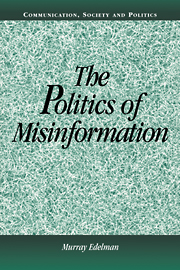8 - Crime as an Example
Published online by Cambridge University Press: 05 June 2012
Summary
This chapter is an extended example of how images, authority, public opinion, institutions, language, and putative scientific knowledge combine to create obstacles to change and occasions for error.
Once established, inequalities are likely to be perpetuated and reinforced by symbols, concepts, and actions that people employ every day. As an example of this phenomenon, this chapter examines the creation and consequences of beliefs about crime in late twentieth-century America where crime had become the most publicized and disturbing social problem. The perpetuation of inequalities by such symbols could equally well be demonstrated by studies of such social issues as poverty, unemployment, taxes, and health care.
So far as crime is concerned we are caught in a vicious circle: Crime creates powerful symbolism and spurious logic, which, in turn, help promote still more crime. More exactly, it is a vicious spiral, for the misconceptions and the ominous social consequences have been escalating. It is time to stand outside the spiral and understand just what is happening.
The deployment of language is central to beliefs and policies regarding crime. There has been a revolution in our understanding of language in the twentieth century. It has taught us, among other things, that language does not offer a description of an objective world. Language, rather, is a creator of the realities in which we live and move: It is a framer of worlds with particular features.
- Type
- Chapter
- Information
- The Politics of Misinformation , pp. 112 - 128Publisher: Cambridge University PressPrint publication year: 2001

